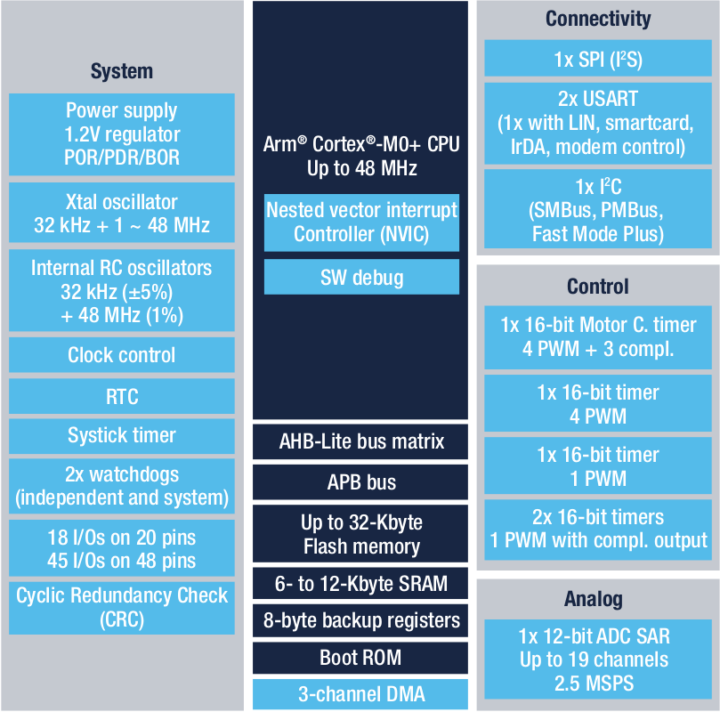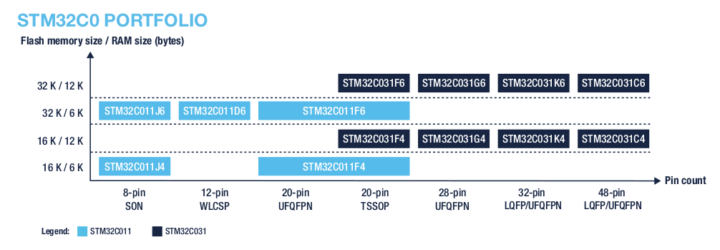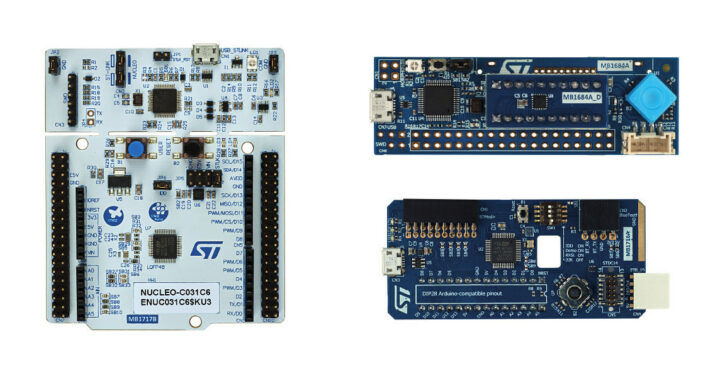8-bit MCUs are still found in many designs, but with the new low-cost 48MHz STM32C0 32-bit Arm Cortex-M0+ microcontroller, STMicroelectronics aims to displace 8-bit microcontrollers thanks to “a limited impact on the cost structure” and the improved support provided by the STM32 ecosystem.
The cheapest ever STM32 microcontroller offers up to 32 KB flash, 6 or 12 KB RAM, and I/O interfaces such as UART, I2C, SPI, 12-bit ADC, and so on. The STM32C0 MCUs are available in 8- to 48-pin packages such as WLCSP12, UFQFPN, and the ridiculously tiny 1.70 x 1.42 mm WLCSP12 package.
STMicro STM32C0 key features and specifications:
- MCU Core -Arm 32-bit Cortex-M0+ CPU @ up to 48 MHz
- Memory – 6KB (STM32C011x4/x6) or 12KB (STM32C031x4/x6) SRAM with HW parity check
- Storage – 32KB flash with protection
- Peripheral interfaces
- Up to 45x fast I/Os some of which are 5V tolerant; Note: up to 18x fast I/Os for STM32C011x4/x6
- 3-channel DMA controller
- 12-bit, 0.4 µs ADC (up to 13 ext. channels); range: 0 to 3.6 V
- I2C up to 1 Mbps
- 2x USARTs with master/slave synchronous SPI; one supporting ISO7816 interface, LIN, IrDA capability, auto baud rate detection, and wakeup feature
- 1x SPI up to 24 Mbps with 4- to 16-bit programmable bitframe; multiplexed with I2S audio interface
- Timers
- 16-bit for advanced motor control
- 4x 16-bit general-purpose
- 2x watchdogs,
- SysTick timer
- Calendar RTC with alarm
- Debugging – Serial wire debug (SWD)
- CRC calculation unit
- Clock management
- 4 to 48 MHz crystal oscillator
- 32 kHz crystal oscillator with calibration
- Internal 48 MHz RC oscillator (±1 %)
- Internal 32 kHz RC oscillator (±5 %)
- Reset and power management
- Voltage range: 2.0 V to 3.6 V
- Power-on/Power-down reset (POR/PDR)
- Programmable Brownout reset (BOR)
- Low-power modes: Sleep, Stop, Standby, Shutdown
- Packages
- STM32C011x4/x6
- SO8N (4.9 x 6 mm)
- WLCSP12 (1.70 x 1.42 mm)
- TSSOP20 (6.4 x 4.4 mm)
- UFQFPN20 (3 x 3 mm)
- STM32C031x4/x6
- TSSOP20 (6.4 × 4.4 mm)
- LQFP32 (7 × 7 mm)
- LQFP48 (7 × 7 mm)
- UFQFPN28 (4 × 4 mm)
- UFQFPN32 (5 × 5 mm)
- UFQFPN48 (7 × 7 mm)
- STM32C011x4/x6
- Temperature Ranges – -40°C to 85°C/105°C/125°C
The current STM32C0 portfolio includes two sub-family the STM32C011 with 6KB SRAM and up to 18 I/Os, and the STM32C031 with 12KB SRAM and up to 45 I/Os. STMicro says the STM32C0x1 shares the platform as the STM32G0 and “benefits from a consistent pinout mapping” which I suppose means pin-to-pin compatibility for equivalent packages.
The new 32-bit Cortex-M0+ microcontroller family is supported by the same tools as other STM32 MCUs with the STM32CubeC0 package including the STM32Cube HAL and low-layer (LL) APIs peripheral drivers, plus a set of middleware components (Azure RTOS, USB, USB Power Delivery, FatFS, graphics, and STM32 touch sensing). Embedded software utilities come with examples running on the STM32C0 boards shown below.
On the left side, we have the NUCLEO-C031C6 prototyping board with Arduino and ST Morpho headers, and on the right the STM32C0116-DK wired sample board (MB1684A) and the STM32C0316-DK mini evaluation board (MB1716A).
STMicro STM32C0 microcontrollers are in mass production now, and unit pricing for 500 pieces starts at $1.02 on STMicro’s eStore. The NUCLEO-C031C6 development board can be purchased for $20.69, while the STM32C0116-DK and STM32C0316-DK boards go for $22.05 and $34.08 respectively. More details can be found on the product page.

Jean-Luc started CNX Software in 2010 as a part-time endeavor, before quitting his job as a software engineering manager, and starting to write daily news, and reviews full time later in 2011.
Support CNX Software! Donate via cryptocurrencies, become a Patron on Patreon, or purchase goods on Amazon or Aliexpress








Looks like interesting upgrades to some AVR! Definitely something to watch!
The 8-bit MCU I’m using costs $0.05.
A lot of things are calling themself 8-bit killer, and a lot of Chinese branded parts are much below even AVRs (by a 10-fold at times!), as you are saying.
It would be more accurate to say they try to displace parts with equivalent features but a 8-bit core. Maybe even their own STM8? There are $0.10 RISC-V (hence 32-bit) MCUs too… Still not $0.05! 😀
The ST prices seems still artificially high. We start to see some vendors offering pre-shortage prices for all STM32 parts: The much more powerful STM32G0 can be found at $0.42. So the prices of that chip will hopefully be driven down once they reach the market.
I’d use that CH32V003 if they’d release support allowing a host CPU to update the flash it in the field. The $0.05 CPU is OTP.
That sounds interesting. What MCU is that and where do you get it at that price?
The Padauk chips
http://www.padauk.com.tw/index_en.aspx
Also covered on CNX Software @ https://www.cnx-software.com/2019/08/14/padauk-pms150c-3-cents-mcu-supports-sdcc-open-source-toolchain/
Unless your product sells in 100k quantities, price of $0.05 is irrelevant since this will be just very small part of overall product price.
Many people do work in those volumes. I paid for my sallary many moons ago by helping the layout engineer remove some jumpers from a single sided board design. A penny each at a quarter million boards/year adds up pretty quickly to actual money. Not everyone is a hobbiest. If you’d spend time around here, you’d be more familiar with the person your’re replying to.
Great! Now when are they shipping my lot of F413 and F103 s?
I like that the C011 is available in 3x3mm UFQFPN20. Wanting a small package like that (without dealing with the PCB fab hassles of WLCSP) is one reason a project I’m involved in still uses AVR. But, $1 is not a low cost MCU these days. That same $1 can get you an ESP32 or RP2040 processor with multiple cores and 100’s of KB of ram. Or you can get an 8 bitter for 10 cents or less. But, the 10 cent RISC-V someone mentioned is, afaik, not yet available.
You can get the CH32V003 (the 10 cent RISC chip) on Aliexpress.
https://www.aliexpress.us/item/3256804850399956.html
It is actually 10c a chip on Aliexpress plus shipping.
We covered that one @ https://www.cnx-software.com/2022/10/22/10-cents-ch32v003-risc-v-mcu-offers-2kb-sram-16kb-flash-in-sop8-to-qfn20-packages/
Oh that is nice, thanks! I’d like to know how the analog features compare to an AVR since the AVR app that I’m involved with makes use of them. It would also be good to have one with more program flash, like 32K instead of 16K, since otherwise the CH32V003 is only at parity with the small AVR’s (AT1616 etc.)
Get the datasheet here:
http://www.wch-ic.com/downloads/CH32V003RM_PDF.html
BTW. There are a whole series of chips in this product line. If the 10c model doesn’t have what you need there are 15c, 20c, etc options.
A dev board might be more useful
https://www.aliexpress.us/item/3256804778040328.html
CH32V003 is available in 3x3mm QFN20
Pretty sure the stm32F0 and stm32G0 families where both also marketed as 8/16-bit replacements. These parts (C0) are more of the same with slightly less ram.
I like having options..I really do, but there’s such a thing as too many STM32 options….F0, F1, F2, F3, F4, F7, L0, L4, G0, G4, H7, U5 C0, WB, WL most have scant availability.
Also the HAL libraries where designed to be ‘cross compatible’ across all families. This causes all sorts of inefficiencies when trying to abstract the hardware using a unified API.
Having said that, I do like the development board with a DIL-20 breakout.
Hi,
First, let me introduce myself: I’m in charge of STM32F0/G0/C0 at ST. You can see that we care a lot about developer’s feedbacks, as we do do from our customers, and we remain very humble, always.
About your point on many Series. It is probably a matter of MCU generations, and because ST commits on long product life, finally after more than 10 years it can seem a lot. Here, you can see STM32F0 as Gen1, STM32G0 as Gen2 offering F0 features + many more capabilities, and STM32C0 is now complementary to STM32G0 from the low-end. STM32C0 is sharing the same technology, same optimized pinout and IP set as G0, focusing on what is essential to really bridge on cost and ease-of-use with similar 8-bit MCUs, with 32-bit capabilities. Both articulate perfectly when you need to downgrade or upgrade. if you need something more on C0, then look at STM32G0. And vice-versa. I hope I explained the philosophy and I’m sure that once you try, you are convinced. 😉
Last notice: the STM32C0 board prices have decreased vs this article. All should be below $20 now.